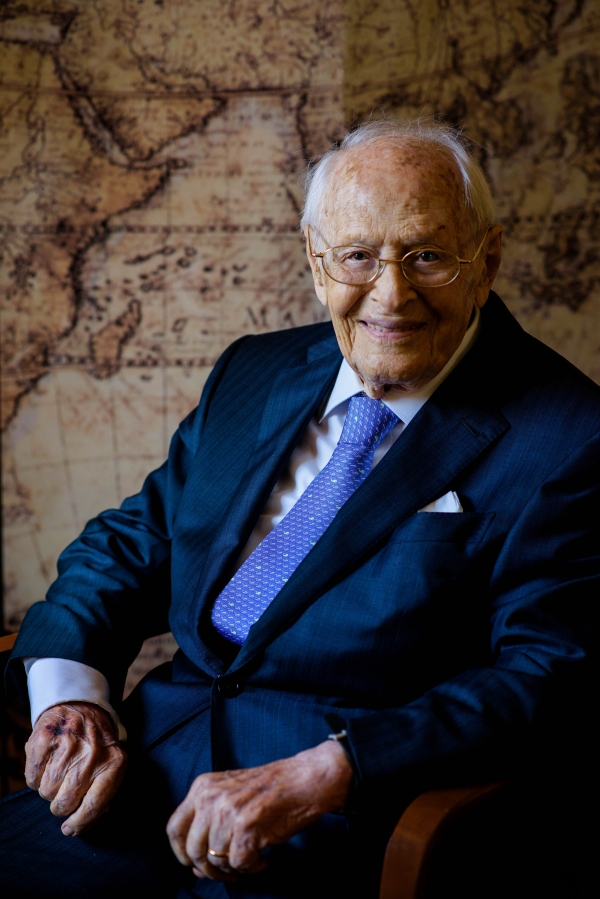Atherton resident George Rosenkranz, renowned in his field for his work in developing the birth control pill, died on Sunday, June 23, at age 102.
Rosenkranz, a chemist, also developed a drug to treat rheumatoid arthritis, according to The New York Times. His grandson Adrian Rosenkranz confirmed his passing in a June 24 email.
Rosenkranz was born in Budapest, Hungary, in 1916. He studied piano as a teenager at the Liszt Academy, according to an obituary on the Sinai Memorial Chapel website. He received a doctorate in chemistry in 1940 at the Swiss Federal Institute of Technology while studying under Lepold Ružička, a Nobel prize-winning chemist, according to the obituary. He fled Switzerland in 1941 to escape the Nazis and ended up in Cuba, where he worked as the director of a chemical manufacturing laboratory, according to the obituary.
In Cuba, he met Edith Stein, whom he married in 1945.
The pair moved to Mexico that year, where Rosenkranz worked for the Mexican pharmaceutical company Syntex, according to the obituary. He eventually became the company's chief operating officer.
In 1951, Rosenkranz led and directed the research team at Syntex that was responsible for the synthesis of norethindrone, the first active ingredient of the birth control pill. The team included the late Carl Djerassi, whose Woodside ranch is now an artist colony, and a student, Luis E. Miramontes.
Rosenkranz received the Biotechnology Heritage Award in 2013 and the Dr. Leopoldo Rio de la Loza Mexican National Prize in Pharmaceutical Sciences in 1994. In 2001, he received from the president of Mexico the Eduardo Liceaga Medal, Mexico's highest honor for contributions to health sciences. On July 12, 2016, the U.S. House of Representatives honored Rosenkranz on his 100th birthday, according to the obituary.
Rosenkranz had a life-long passion for bridge. He won 12 North American Bridge Championships, more than 100 Mexican National Championships, and wrote 14 books on bridge. He was also enshrined in the American Contract Bridge League Hall of Fame, according to the obituary.
During Syntex's early years, Rosenkranz used Syntex funds to underwrite an advanced degree program in organic chemistry at the University of Mexico's Institute of Chemistry, according to a 2002 article in The Magazine of the Pan American Health Organization. The company’s research center eventually relocated to Palo Alto, according to the Science History Institute.
Rosenkranz is survived by his wife Edith and two of their three sons: Roberto and Ricardo. His son Gerardo died in 2011. He is also survived by nine grandchildren, according to the obituary.
A private funeral is scheduled for June 25 at Congregation Beth Am in Los Altos Hills. Rosenkranz lived permanently in Atherton for the last 15 or 20 years, Adrian Rosenkranz said.
"My grandfather was passionate about helping young researchers in their efforts to improve global health," Adrian Rosenkranz said. "For those that wish, consider a gift to The Rosenkranz Prize at Stanford University."
Gifts can be made online by visiting giving.stanford.edu by clicking "How to Give," Adrian Rosenkranz said. For credit card gifts, select "Centers, Institutes, and More" from the "Gift Details" section. Select "Freeman Spogli Institute for International Studies" from the drop-down list. In the "Special Instructions/Other Designation" box, donors should enter "The Dr. George Rosenkranz Memorial Fund." Checks may also be made out to Stanford University with a memo line for "The Dr. George Rosenkranz Memorial Fund" and sent to Adrian Rosenkranz's attention at 616 Serra Street, Stanford, CA 94305.
-




Comments